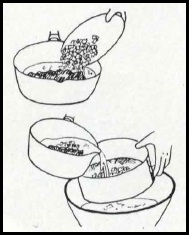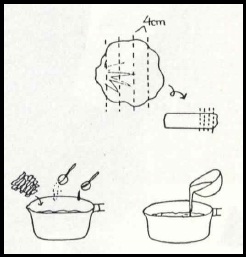by Kanami Egami
Kanaami-san provides basic information on some basic, favorite Japanese culinary specials, beginning with soup stock (“dashi“). This clear soup is made from konbu (kelp) and katsuo-bushi (dried bonito); actually the basics of many Japanese dishes.
Konbu is a variety of dried kelp and sold in long pieces, known as dashi kombu.
Katsuobushi, dried bonito, is one of the basic flavorings of Japanese cuisine, whether used by a restaurant chef or at home. It is one of the most essential ingredients to Japanese cooking. Katsuobushi looks like a dry piece of driftwood. Actually, it is dried bonito fillet. In Japan, products of the sea have been highly esteemed since ancient times.
Perhaps it is no accident that Katsuobushi in calligraphy also means “victorious samurai” — “katsuo” = victory; “bushi” = samurai.
Traditionally, it is presented as a token of regard on any felicitous occasion. The habit of giving katsuobushi, konbu or abalone (awabi) all convey the meaning of joy and happiness.
Four pieces of katsuobushi can be made from one bonito. When the bonito is small, two pieces of katsuobushi can be made from one bonito, but the quality is not as good as the larger ones. To identify the best quality dried bonito, hit two dried pieces together. The sound should be very high pitched. A dull sound usually indicates a crumbly inside. To insure the best flavor, dried bonito should be shaved just before making the stock. Labelled “kezuri-bushi,” or shaved bonito, katsuobushi flakes can be purchased in packets.
Sebushi Harabushi Kamebushi
Sebushi == Katsubusho of back fillet (high quality)
Harabushi == Katsuobushi of vein fillet (rich and strong flavor)
Kamebushi == Katsuobushi of small bonito
REGULAR KONBU DASHI
To make 5 cups of dashi:
10 cm. x 15 cm. konbu
8 g. shaved dried bonito
5 1/2 cups water
Directions:
(1) Place the bonito and konbu in a medium sized soup pot. Add 2 1/2-3 cups of water. Simmer for 3 minutes.
(2) Filter through a silk-lined sieve (a special sieve for making dashi). You can use cheesecloth or a paper towel instead of the special sieve.
Instant dashi, often called dashi-no-moto in both powder and thick liquid forms, can be found in your neighborhood market. For variety or in the case of unavailability, you can use other dried fish for your dashi, such as dried flying fish or dried young sardines (niboshi). The latter are put into cold water, left to stand overnight and filtered through a sieve. (40 g. dried sardines makes 5 cups of stock.)
We recommend you try the cabbage and egg soup, using the basic soup stock as described above.
CABBAGE & EGG SOUP
Ingredients:
30 g. cabbage
2 eggs
3 1/2 cups soup stock
salt
soy sauce
Directions:
(1) Cut cabbage into 4 cm.-long strips.
(2) Beat eggs lightly and add a pinch of salt
(3) Put the soup stock in a pan. Season with salt and soy sauce. Add cabbage and simmer for 30 seconds. Add eggs and bring to a boil. Cover and let stand for 20 seconds. Serve.










